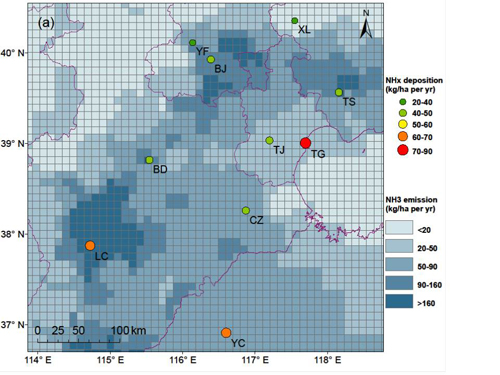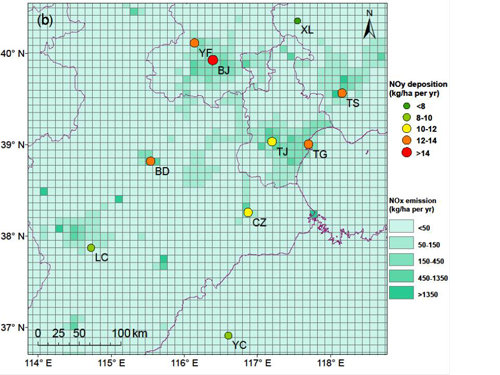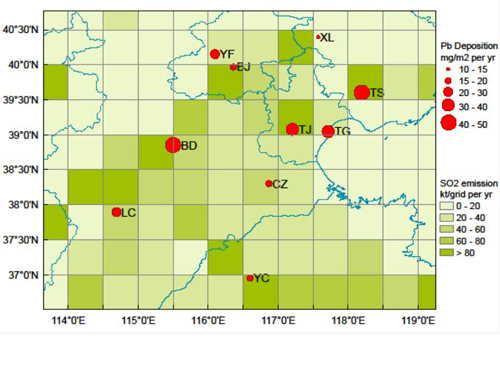Atmospheric deposition is considered to be a major process that removes pollutants from the atmosphere and an important source of nutrients and contaminants for ecosystems. Although previous studies have defined the aerosol/precipitation chemistry at a number of sites, spatial and temporal information regarding wet and dry deposition derived from local and regional emissions in China is limited. To advance our understanding of the transportation and transformation of pollutants from the local to the regional and global scales, our knowledge of the quantitative aspects of atmospheric deposition must be updated with detailed spatiotemporal descriptions. Therefore, a new monitoring network including 10 well-distributed sites within the target areas was established in late 2007. The focus of the program was to evaluate the wet and dry deposition of the important trace species, including carbon, nitrogen, sulfur, phosphorus, heavy metals, and polycyclic aromatic hydrocarbons (PAHs). The observations of this monitoring network have recently been presented, with an emphasis on acids and nutrients that most affect natural ecosystems. With the substantial anthropogenic emissions, toxic metals deposited on plants and into soil or water can cause substantial damage to the environment and human health due to their transfer and accumulation in food chains. The monitoring network conducted the quantitative description of elemental deposition in China, but has not yet been published as a whole.

New global hotspot of atmospheric deposition
Prof. Wang Yuesi and Dr. Pan Yuepeng from Institute of Atmospheric Physics, Chinese Academy of Sciences presented the first concurrent measurements of wet and dry deposition in Northern China, covering an extensive area over 3 years in a global hotspot of air pollution. It was found that, besides sulfur (Fig. 1) and nitrogen (Fig. 2), the wet and dry depositions of lead (Fig. 3) and other trace elements (TEs) in the target areas were also orders of magnitude higher than previous observations within and outside China, generating great concern over the potential risks. The spatial distribution of the total (wet plus dry) deposition flux was consistent with that of the dry deposition, with a significant decrease from industrial and urban areas to suburban, agricultural and rural sites, while the wet deposition exhibited less spatial variation. In addition, the seasonal variation of wet deposition was also different from that of dry deposition, although they were both governed by the precipitation and emission patterns.

Fig. 1 Atmospheric deposition of sulfur in Northern China (SO2 emission from Zhang et al., 2009)

Fig. 2a Atmospheric deposition of nitrogen (NHx) in Northern China

Fig. 2b Atmospheric deposition of nitrogen (NOy) in Northern China
Fig. 3 Atmospheric deposition of lead in Northern China (SO2 emission from Zhang et al., 2009)
For the majority of TEs that exist as coarse particles, dry deposition dominated the total flux at each site. This was not the case for potassium, nickel, arsenic, lead, zinc, cadmium, selenium, silver and thallium, for which the relative importance between wet and dry deposition fluxes varied by site. Whether wet deposition is the major atmospheric cleansing mechanism for the TEs depends on the size distribution of the particles.
They found that atmospheric inputs of copper, lead, zinc, cadmium, arsenic and selenium were of the same magnitude as their increases in the topsoil of agricultural systems. At a background forest site in Northern China, the total deposition flux of lead observed in this study (14.1 mg m−2 yr−1) was twice that of the critical load calculated for temperate forest ecosystems in Europe. These findings provide baseline data needed for future targeting policies to protect various ecosystems from long-term heavy metal input via atmospheric deposition.
The finding is recently published in Atmos. Chem. Phys. (IF=5.3). The unique field data can serve as a sound basis for the validation of regional emission inventories and biogeochemical or atmospheric chemistry models. The findings are very important for policy makers to create legislation to reduce the emissions and protect soil and water from air pollution.
Contact: Prof. Wang Yuesi (wys@mail.iap.ac.cn) and Dr. Pan Yuepeng (panyuepeng@mail.iap.ac.cn)
Citations:
Pan, Y. P. and Wang, Y. S.: Atmospheric wet and dry deposition of trace elements at 10 sites in Northern China, Atmos. Chem. Phys., 15, 951-972, doi:10.5194/acp-15-951-2015, 2015.(http://www.atmos-chem-phys.net/15/951/2015/acp-15-951-2015.html)
Pan, Y. P., Wang, Y. S., Tang, G. Q., and Wu, D.: Spatial distribution and temporal variations of atmospheric sulfur deposition in Northern China: insights into the potential acidification risks, Atmos. Chem. Phys., 13, 1675-1688, doi:10.5194/acp-13-1675-2013, 2013. (http://www.atmos-chem-phys.net/13/1675/2013/acp-13-1675-2013.html)
Pan, Y. P., Wang, Y. S., Tang, G. Q., and Wu, D.: Wet and dry deposition of atmospheric nitrogen at ten sites in Northern China, Atmos. Chem. Phys., 12, 6515-6535, doi:10.5194/acp-12-6515-2012, 2012. (http://www.atmos-chem-phys.net/12/6515/2012/acp-12-6515-2012.html)










